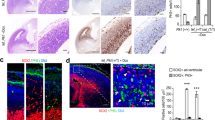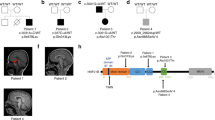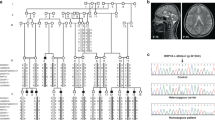Abstract
Centrioles are microtubule-based, barrel-shaped structures that initiate the assembly of centrosomes and cilia1,2. How centriole length is precisely set remains elusive. The microcephaly protein CPAP (also known as MCPH6) promotes procentriole growth3,4,5, whereas the oral-facial-digital (OFD) syndrome protein OFD1 represses centriole elongation6,7. Here we uncover a new subtype of OFD with severe microcephaly and cerebral malformations and identify distinct mutations in two affected families in the evolutionarily conserved C2CD3 gene. Concordant with the clinical overlap, C2CD3 colocalizes with OFD1 at the distal end of centrioles, and C2CD3 physically associates with OFD1. However, whereas OFD1 deletion leads to centriole hyperelongation, loss of C2CD3 results in short centrioles without subdistal and distal appendages. Because C2CD3 overexpression triggers centriole hyperelongation and OFD1 antagonizes this activity, we propose that C2CD3 directly promotes centriole elongation and that OFD1 acts as a negative regulator of C2CD3. Our results identify regulation of centriole length as an emerging pathogenic mechanism in ciliopathies.
This is a preview of subscription content, access via your institution
Access options
Subscribe to this journal
Receive 12 print issues and online access
$209.00 per year
only $17.42 per issue
Buy this article
- Purchase on Springer Link
- Instant access to full article PDF
Prices may be subject to local taxes which are calculated during checkout






Similar content being viewed by others
Accession codes
References
Paintrand, M., Moudjou, M., Delacroix, H. & Bornens, M. Centrosome organization and centriole architecture: their sensitivity to divalent cations. J. Struct. Biol. 108, 107–128 (1992).
Bettencourt-Dias, M. & Glover, D.M. Centrosome biogenesis and function: centrosomics brings new understanding. Nat. Rev. Mol. Cell Biol. 8, 451–463 (2007).
Kohlmaier, G. et al. Overly long centrioles and defective cell division upon excess of the SAS-4–related protein CPAP. Curr. Biol. 19, 1012–1018 (2009).
Tang, C.-J.C., Fu, R.-H., Wu, K.-S., Hsu, W.-B. & Tang, T.K. CPAP is a cell-cycle regulated protein that controls centriole length. Nat. Cell Biol. 11, 825–831 (2009).
Schmidt, T.I. et al. Control of centriole length by CPAP and CP110. Curr. Biol. 19, 1005–1011 (2009).
Ferrante, M.I. et al. Identification of the gene for oral-facial-digital type I syndrome. Am. J. Hum. Genet. 68, 569–576 (2001).
Singla, V., Romaguera-Ros, M. & García-Verdugo, J.M. Ofd1, a human disease gene, regulates the length and distal structure of centrioles. Dev. Cell 18, 410–424 (2010).
Gurrieri, F., Franco, B., Toriello, H. & Neri, G. Oral-facial-digital syndromes: review and diagnostic guidelines. Am. J. Med. Genet. A. 143A, 3314–3323 (2007).
Patel, S. & Barkovich, A.J. Analysis and classification of cerebellar malformations. AJNR Am. J. Neuroradiol. 23, 1074–1087 (2002).
Zhang, D. & Aravind, L. Novel transglutaminase-like peptidase and C2 domains elucidate the structure, biogenesis and evolution of the ciliary compartment. Cell Cycle 11, 3861–3875 (2012).
Hoover, A.N. et al. C2cd3 is required for cilia formation and Hedgehog signaling in mouse. Development 135, 4049–4058 (2008).
Zohn, I.E., Anderson, K.V. & Niswander, L. Using genomewide mutagenesis screens to identify the genes required for neural tube closure in the mouse. Birth Defects Res. A Clin. Mol. Teratol. 73, 583–590 (2005).
Poretti, A. et al. Delineation and diagnostic criteria of oral-facial-digital syndrome type VI. Orphanet J. Rare Dis. 7, 4 (2012).
Srour, M. et al. Mutations in C5ORF42 cause Joubert syndrome in the French Canadian population. Am. J. Hum. Genet. 90, 693–700 (2012).
Lopez, E. et al. C5orf42 is the major gene responsible for OFD syndrome type VI. Hum. Genet. 133, 367–377 (2014).
Thomas, S. et al. TCTN3 mutations cause Mohr-Majewski syndrome. Am. J. Hum. Genet. 91, 372–378 (2012).
Dammermann, A. & Merdes, A. Assembly of centrosomal proteins and microtubule organization depends on PCM-1. J. Cell Biol. 159, 255–266 (2002).
Kim, J.C. et al. The Bardet-Biedl protein BBS4 targets cargo to the pericentriolar region and is required for microtubule anchoring and cell cycle progression. Nat. Genet. 36, 462–470 (2004).
Nachury, M.V. et al. A core complex of BBS proteins cooperates with the GTPase Rab8 to promote ciliary membrane biogenesis. Cell 129, 1201–1213 (2007).
Jin, H. et al. The conserved Bardet-Biedl syndrome proteins assemble a coat that traffics membrane proteins to cilia. Cell 141, 1208–1219 (2010).
Lopes, C.A.M. et al. Centriolar satellites are assembly points for proteins implicated in human ciliopathies, including oral-facial-digital syndrome 1. J. Cell Sci. 124, 600–612 (2011).
Kleylein-Sohn, J. et al. Plk4-induced centriole biogenesis in human cells. Dev. Cell 13, 190–202 (2007).
Strnad, P. et al. Regulated HsSAS-6 levels ensure formation of a single procentriole per centriole during the centrosome duplication cycle. Dev. Cell 13, 203–213 (2007).
Mogensen, M.M., Bornens, M., Malik, A., Piel, M. & Bouckson-Castaing, V. Microtubule minus-end anchorage at centrosomal and non-centrosomal sites: the role of ninein. J. Cell Sci. 113, 3013–3023 (2000).
Garcia-Gonzalo, F.R. & Reiter, J.F. Scoring a backstage pass: mechanisms of ciliogenesis and ciliary access. J. Cell Biol. 197, 697–709 (2012).
Spektor, A., Tsang, W.Y., Khoo, D. & Dynlacht, B.D. Cep97 and CP110 suppress a cilia assembly program. Cell 130, 678–690 (2007).
Giorgio, G. et al. Functional characterization of the OFD1 protein reveals a nuclear localization and physical interaction with subunits of a chromatin remodeling complex. Mol. Biol. Cell 18, 4397–4404 (2007).
Salisbury, J.L., Suino, K.M., Busby, R. & Springett, M. Centrin-2 is required for centriole duplication in mammalian cells. Curr. Biol. 12, 1287–1292 (2002).
Azimzadeh, J. et al. hPOC5 is a centrin-binding protein required for assembly of full-length centrioles. J. Cell Biol. 185, 101–114 (2009).
Balestra, F.R., Strnad, P., Flückiger, I. & Gönczy, P. Discovering regulators of centriole biogenesis through siRNA-based functional genomics in human cells. Dev. Cell 25, 555–571 (2013).
Comartin, D. et al. CEP120 and SPICE1 cooperate with CPAP in centriole elongation. Curr. Biol. 23, 1360–1366 (2013).
Lin, Y.-N. et al. CEP120 interacts with CPAP and positively regulates centriole elongation. J. Cell Biol. 202, 211–219 (2013).
Reddick, L.E. & Alto, N.M. Correlative Light and Electron Microscopy (CLEM) as a tool to visualize microinjected molecules and their eukaryotic sub-cellular targets. J. Vis. Exp. (63), e3650 (2012).
Thompson, J.R., Ryan, Z.C., Salisbury, J.L. & Kumar, R. The structure of the human centrin 2-xeroderma pigmentosum group C protein complex. J. Biol. Chem. 281, 18746–18752 (2006).
Seelow, D., Schuelke, M., Hildebrandt, F. & Nurnberg, P. HomozygosityMapper—an interactive approach to homozygosity mapping. Nucleic Acids Res. 37, W593–W599 (2009).
Li, H. & Durbin, R. Fast and accurate short read alignment with Burrows-Wheeler transform. Bioinformatics 25, 1754–1760 (2009).
McKenna, A. et al. The Genome Analysis Toolkit: a MapReduce framework for analyzing next-generation DNA sequencing data. Genome Res. 20, 1297–1303 (2010).
DePristo, M.A. et al. A framework for variation discovery and genotyping using next-generation DNA sequencing data. Nat. Genet. 43, 491–498 (2011).
Koressaar, T. & Remm, M. Enhancements and modifications of primer design program Primer3. Bioinformatics 23, 1289–1291 (2007).
Adzhubei, I.A. et al. A method and server for predicting damaging missense mutations. Nat. Methods 7, 248–249 (2010).
Desmet, F.-O. et al. Human Splicing Finder: an online bioinformatics tool to predict splicing signals. Nucleic Acids Res. 37, e67 (2009).
Breslow, D.K., Koslover, E.F., Seydel, F., Spakowitz, A.J. & Nachury, M.V. An in vitro assay for entry into cilia reveals unique properties of the soluble diffusion barrier. J. Cell Biol. 203, 129–147 (2013).
Cardona, A. et al. TrakEM2 software for neural circuit reconstruction. PLoS ONE 7, e38011 (2012).
Schindelin, J. et al. Fiji: an open-source platform for biological-image analysis. Nat. Methods 9, 676–682 (2012).
Acknowledgements
We thank L. Pelletier (Lunenfeld Institute, University of Toronto), M. Bornens (Institut Curie, Paris), C. Janke (Institut Curie, Orsay), T. Stearns (Stanford University) and A. Merdes (CNRS, Université de Toulouse) for antibodies against SASS6, ninein, glutamylated tubulin, CEP164 and PCM-1, respectively, A. Liu for the C2cd3-mutant MEFs and C2cd3 cDNA, J. Reiter for Ofd1 cDNA, S. Munro for pRFP-PACT, V. Meyer (Genoscope, Centre National de Génotypage), T. Hardy (University of Leicester) and N. Elkhartoufi (Necker, Paris) for technical support, F. Collman (Stanford University) for help with serial alignment, members of the Nachury laboratory for helpful discussions, and the patients and their families for their participation. This work was supported by grants from NIGMS (GM089933 to M.V.N.), the GIS–Institut des Maladies Rares (HTS), the French Ministry of Health (PHRC national 2010-A01014-35), the Regional Council of Burgundy (to C.T.-R.), the Wellcome Trust and Kidney Research UK (to A.M.F.), and the Fondazione Telethon (TGM11CB3) and the European Community's Seventh Framework Programme (FP7/2007-2013; 241955) (to B.F.). We also thank the National Heart, Lung, and Blood Institute (NHLBI) Grand Opportunity (GO) Exome Sequencing Project (see URLs) and its ongoing studies that produced and provided exome variant calls for comparison: the Lung GO Sequencing Project (HL-102923), the Women's Health Initiative (WHI) Sequencing Project (HL-102924), the Broad GO Sequencing Project (HL-102925), the Seattle GO Sequencing Project (HL-102926) and the Heart GO Sequencing Project (HL-103010).
Author information
Authors and Affiliations
Contributions
M.V.N. conceived and supervised the functional characterization of C2CD3. C.T.-R. designed and conducted the gene identification strategy with assistance from T.A.-B., B.F., L.F., L.J., E.L., J.-B.R., C.A., N.G., B.A., A. Mégarbané, J.T., J.S.-O. and A.-L.B. J.-B.R. and S.S. performed mapping analysis, genetic screening and mutation analysis. A. Mégarbané, B.F., L.P., P.L. and C.T.-R. identified and recruited subjects. S.G.-G., A. Munnich, F.H. and M.V. gave technical support and conceptual advice. A.M.F. and C.A.M.L. provided OFD1 reagents. M.V.N., J.S.L. and T.S. designed, executed and analyzed the immunohistochemistry, overexpression and protein interaction assays. F.Y. designed and executed the centriole length measurement by light microscopy. V.H.-P. and J.M.G.-V. designed and executed electron microscopy imaging and analysis. C.T.-R. and M.V.N. wrote the manuscript. All authors reviewed the manuscript.
Corresponding authors
Ethics declarations
Competing interests
The authors declare no competing financial interests.
Integrated supplementary information
Supplementary Figure 1 Homozygosity mapping and characterization of C2CD3 mutations.
(a) A 4-Mb region containing 75 genes was identified at chromosome 11q between SNPs rs6592508 and rs7103374 by homozygosity mapping with the Affymetrix 500k SNPs chip. Analysis was performed with HomozigosityMapper (see URLs). (b) Chromatograms of genomic DNA sequencing showing: (left) the homozygous c.184C>T mutation in exon 2 of the C2CD3 gene (NM_015531.4) in patient 1 and at heterozygous status in his parents; (center) the missense variation c.3085T>G in exon 17 found heterozygous in patient 2 and his father; (right) a substitution c.3911–2A>T in the splice acceptor sequence of exon 22 heterozygous in patient 2 and his mother. (c,d) Chromatograms of C2CD3 cDNA sequencing at the junction between exons 21 and 22 in a control individual (c) and in patient 2 (d). (e) Nucleotide sequences of C2CD3 cDNA at the junction between exons 21 and 22 from the reference sequence (NM_015531.4), a control individual and patient 2.
Supplementary Figure 2 C2CD3 interacts with the BBSome and localizes to centriolar satellites.
(a) C2CD3 coimmunoprecipitates with most BBSome subunits. Plasmids encoding GFP-C2CD3 and a Myc-tagged BBSome subunit were cotransfected in HEK cells, and complexes were precipitated with anti-Myc antibody. Inputs and eluates were resolved by SDS-PAGE and immunoblotted for Myc or GFP. For the Myc immunoblot, 2.5 equivalents of eluate and 1 equivalent of lysate were run on the gel. Both Myc immunoblot panels are cropped from the same film exposure. For the GFP immunoblot, 25 equivalents of eluate and 1 equivalent of lysate were run on the gel. Both GFP immunoblot panels are cropped from the same film exposure. (b) C2CD3 localizes to centriolar satellites. IMCD3-[GFP-C2CD3] cells were stained for PCM-1 (red) and DNA (blue). Most foci of C2CD3 signal overlap with PCM-1 except for two spots in the center of the cell (pointed by arrowheads within the magnified region in the inset). Scale bars, 5 μm; the inset is 2 μm by 2 μm. (c) The distribution and overall number of centriolar satellites are not affected by the loss of C2CD3. Heterozygous MEFs or mutant MEFs were stained for PCM-1 (green) and DNA (blue). Scale bar, 5 μm.
Supplementary Figure 3 C2CD3 localization to centrioles does not depend on microtubules.
(a,b) IMCD3-[GFP-C2CD3] cells were incubated in the presence of nocodazole (b) or the equivalent amount of DMSO (a) for 4 h before fixation and processing for immunofluorescence. Cells were stained for tyrosinated tubulin (white), branched-glutamylated tubulin (GT335; pink) and PCM-1 (red). A magnified view of the centrioles is shown in the insets. Scale bars: 5 μm (main panels), 0.5 μm (insets).
Supplementary Figure 4 C2CD3 localizes to centrioles and procentrioles.
(a,b) IMCD3-[GFP-C2CD3] cells stained for (a) centrin (red) and glutamylated tubulin (GT335; pink). Centrin marks the centrioles and procentrioles where C2CD3 is also found. Meanwhile, glutamylated tubulin is only found at the mature centrioles. Importantly, C2CD3 appears to mark a distal structure of the centriole coinciding with centrin, while glutamylated tubulin marks the entire centriole and generates a diffraction-limited spot at the center of the centriole. (b) ODF2 (red; marks the subdistal appendages) and glutamylated tubulin (GT335; blue). All cells were treated with nocodazole before processing for immunofluorescence. All scale bars are 1 μm. (c) GST capture assays, supplement to Figure 2j. The same samples as in Figure 2j were resolved by SDS-PAGE and stained with Coomassie to assess the amounts of the GST-OFD1 fusion pulled down by glutathione-sepharose beads. Asterisks denote full-length GST-OFD1 truncations.
Supplementary Figure 5 Characterization of C2cd3-mutant MEFs.
(a) MEF extracts were immunoblotted for centrin and tubulin (DM1A mAb). (b) MEFs derived from heterozygous (C2cd3Gt/+) and homozygous C2cd3-mutant mice (C2cd3Hty/Hty and C2cd3Gt/Gt) were stained for ninein (green) and centrin (red).
Supplementary Figure 6 Extended gallery of TEM images of centrioles in C2cd3-mutant and control cells.
(a) Longitudinal TEM sections of C2cd3Gt/+ and C2cd3Hty/Hty centrioles. Centrioles from the mutant MEFs appear stunted and lack all appendages (arrows point to subdistal appendages; arrowheads point to distal appendages). Scale bar, 100 nm. (b) Serial transverse TEM sections of C2cd3Gt/+ and C2cd3Hty/Hty centrioles. C2cd3Gt/+ centrioles are contained within 5 to 6 sections, whereas C2cd3Hty/Hty centrioles span fewer than 3 sections. Scale bar, 100 nm.
Supplementary Figure 7 Characterization of the C2CD3-induced elongated structures.
(a) U2OS cells transfected with GFP-C2CD3 were treated with vehicle (top) or 5 μM nocodazole (bottom) for 1 h followed by fixation and staining for tubulin (DM1A; white), acetylated tubulin (red) and DNA. The diffuse tubulin staining in nocodazole-treated cells corresponds to the free tubulin dimers in the cytoplasm. Scale bars, 5 μm. (b) Serial sections of the hyperelongated centriole shown in Figure 5f. (c) RPE cells transfected with GFP-C2CD3 were stained for tubulin (red). GFP-C2CD3 colocalizes extensively with bundles of microtubules. Scale bar, 5 μm.
Supplementary information
Supplementary Text and Figures
Supplementary Figures 1–7 and Supplementary Tables 1 and 2. (PDF 62875 kb)
Hyperelongated centriole from Figure 5f.
The five serial sections of the hyperelongated centriole shown in Figure 5f and Supplementary Figure 7b are displayed as an animation. A separate structure that does not appear to be connected to the centriole can be seen in the last two sections. (MOV 858 kb)
Rights and permissions
About this article
Cite this article
Thauvin-Robinet, C., Lee, J., Lopez, E. et al. The oral-facial-digital syndrome gene C2CD3 encodes a positive regulator of centriole elongation. Nat Genet 46, 905–911 (2014). https://doi.org/10.1038/ng.3031
Received:
Accepted:
Published:
Issue Date:
DOI: https://doi.org/10.1038/ng.3031
This article is cited by
-
Single-molecule localization microscopy reveals the ultrastructural constitution of distal appendages in expanded mammalian centrioles
Nature Communications (2023)
-
INTS13 variants causing a recessive developmental ciliopathy disrupt assembly of the Integrator complex
Nature Communications (2022)
-
High diagnostic yield in skeletal ciliopathies using massively parallel genome sequencing, structural variant screening and RNA analyses
Journal of Human Genetics (2021)
-
TALPID3 and ANKRD26 selectively orchestrate FBF1 localization and cilia gating
Nature Communications (2020)
-
CEP120 interacts with C2CD3 and Talpid3 and is required for centriole appendage assembly and ciliogenesis
Scientific Reports (2019)



